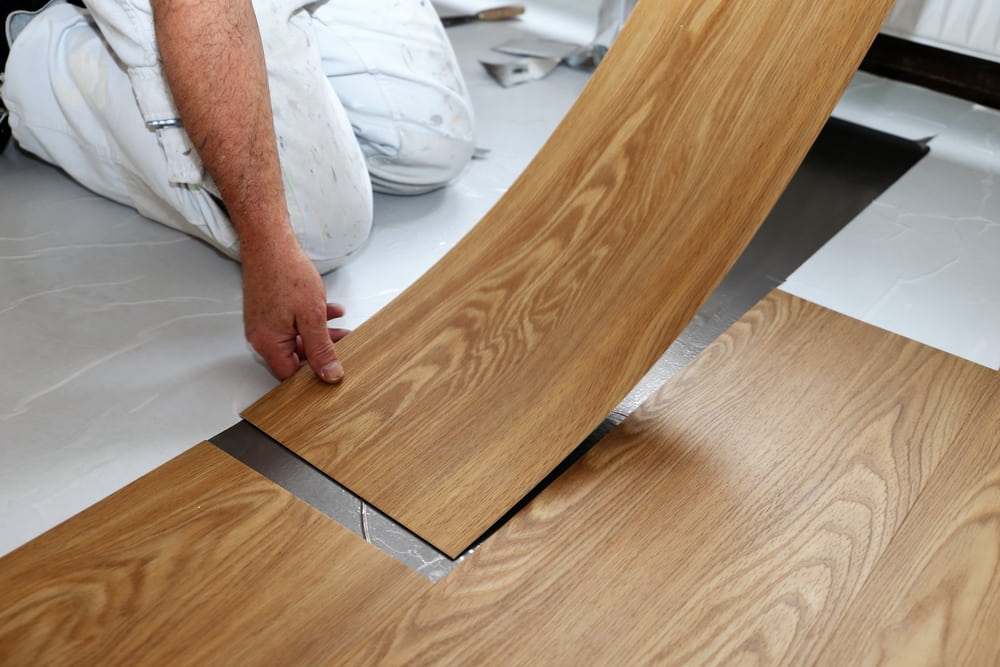When vinyl or PVC was accidentally created in the 1800’s no one could have predicted how useful the material would become. With uses stretching across every industry it was only a matter of time before it was adapted to be used as a flooring. Vinyl has been used as a flooring solution since the early 1930’s when Vinyl Composite Tile was introduced as a durable resilient flooring. It was inexpensive to produce and proved to be a long-lasting solution.
Fast forward 80 years and vinyl has evolved into a more sophisticated and diverse product. Today’s Vinyl plank and tile are some of the most popular segments in flooring. They create some of the most durable finishes and can be used to replicate any look imaginable.
Now that Vinyl plank has been in the market for a substantial amount of time, it has developed into two main categories:
- Click systems
- Glued systems
While both have their own advantages and disadvantages, they generally are very similar in construction. The major difference is in how they are installed.
Click vinyl planks are designed to become a floating floor, allowing for an installation to be completed without anything being attached to the sub-floor. This allows for an individual to avoid using any adhesives to make for easy removal down the road. It also allows the floor to expand and contract as one unit, instead of individual planks.
Click systems have become an advantage in climates that have large temperature swings as you will not run into gapping issues if the floor shrinks. The major disadvantage comes into play if damage occurs to a board, which would require replacement. With most click vinyl planks the only solution is to unclick your floor up to the damaged plank, replace it, and click everything back together. This is much more work than its glued down counterpart.
Glue down & modified loose lay vinyl planks are designed to be installed using pressure sensitive adhesives. This allows for a very robust semi permanent installation that will last a very long time, even in commercial applications. A full spread glue down install will have adhesive troweled onto the sub-floor in all areas. The plank is then placed down when the adhesive has tacked up to the installer’s preference. The longer the installer waits for the glue to tac up, the less permanent of an installation it becomes.
A modified loose lay application would have the installer only adhere planks around the border of the install area. This creates a frame of adhered planks to prevent the loose planks in the center from shifting. Both installation methods can be preferred, it just comes down to what method works best for the situation.
The disadvantage to the glue down planks is they are susceptible to shrinkage or expansion. In recent years this has been combated with core technologies that ensure the planks are stable up to temperatures upwards of 60 degrees Celsius. The feature to look for would be sheets of fiberglass added to the product’s core. This has become the new standard in vinyl plank, and as such most product lines include this feature. However, it is something to be aware of because there are still products that do not have this fail-safe.
The last major advantage to both styles of vinyl plank is the water resistance or proofing. With a common situation of a dishwasher or fridge leaking in a kitchen, both hardwood and laminate are generally damaged past repair. With much of the vinyl plank being waterproof, this problem has been eliminated. The second benefit is found when installing vinyl in basements. Being a commonly flooded area that is very susceptible to moisture, a waterproof product is great! In most situations the vinyl can be dried and reused with no issues. This can save a lot of time, money and headaches in an already bad situation. With so much flooding issues in Calgary and surrounding area, this feature alone has made vinyl a popular choice among Albertans.
The final aspect of vinyl plank that needs to be considered is the overall thickness of the product. This comes into play when the floor you are installing your plank on has imperfections. The thicker the vinyl plank, the more imperfections it can compensate for. A common situation this affects is if your sub-floor has minor cracks or gouges. A 2mm thick product is going to show most of these imperfections as it will eventually conform to whatever is beneath it. A 5mm thick plank will hide much more of these imperfections as it is too thick to conform to every imperfection. This makes floor prep a large factor when dealing with vinyl plank. If a 2mm vinyl costs less than a 5mm plank, however requires substantial floor leveling/patching to install properly, the 5mm plank may be closer to the same overall price as it would not require the same preparations.
At the end of the day vinyl plank has become a great solution for most flooring needs. Give us a call, drop us a note or come down and see us if you are interested in learning more or looking at some samples. Deerfoot Carpet & Flooring has knowledgeable staff that can delve further into things for you, and help you decide what vinyl plank is for you!


































